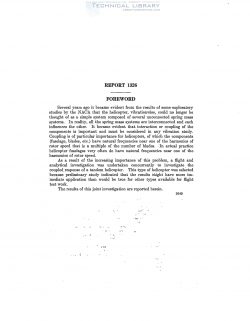naca-report-1326
- Version
- 214 Downloads
- 2.02 MB File Size
- 1 File Count
- November 2, 2016 Create Date
- November 2, 2016 Last Updated
National Advisory Committee for Aeronautics, Report - Flight and Analytical Methods for Determining the Coupled Vibration Response of Tandem Helicopters

As helicopters have become larger and more flexible, the
magnitude of the vibrations associated with these machines
has increased. Available information indicates that high
vibration levels are attributable to many sources, the primary
sources being aerodynamic loading of the rotor blades and
resonance amplification of the structure.
Because of speed changes and periodic variation in the
angle of attack encountered by the rotor blades, alternating
air forces act on the blades once per revolution and at mul-
tiples of this frequency. In general, only those forces which
have a frequency that is a multiple of the number of blades
per rotor are transmitted to the structure in the vertical
direction. The alternating forces which are transmitted are
usually small in comparison to the weight, but if the fre—
quency of the transmitted force is near the structural reso—
nance frequency, then large amplification may occur.
In some of the early designs, attempts were made to lower the
vibration level by setting the natural frequencies of the heli-
copter components, such as the blades, fuselage, and engine,
between the multiples of rotor speed. This approach to the
problem was only partially successful. Some calculations
indicated that coupling of rotor blade bending and fuselage
bending might bring about structural resonance at frequencies
where none was apparent from considerations of each compo—
nent separately. It became apparent that the helicopter
must be treated as a coupled system and that the effect of
the interaction of the components (blades, fuselage,engine,
etc.) is important. The problem is to design and calculate
more accurately so that determination of the coupled response
frequencies of the structure is possible before the prototype
is built.
As a result of the increasing importance of this problem,
a flight investigation of the vibrations encountered by a
typical tandem helicopter has been undertaken at the Lang-
ley Aeronautical Laboratory. Concurrently a theoretical
investigation (ch. H) was undertaken to determine the
coupled natural frequencies of a helicopter whose physical
characteristics are practically identical to those of the heli-
copter used for the flight tests. The purpose of the present
investigation was to determine the importance of coupling
and to find out which structural components are of primary
importance in calculating resonances. The helicopter chosen
for this investigation was known to have a high vibration
level under certain conditions; any changes that were made
to this vibration level by the test methods would be recog-
nized.
| File | Action |
|---|---|
| naca-report-1326 Flight and Analytical Methods for Determining the Coupled Vibration Response of Tandem Helicopters.pdf | Download |

Comment On This Post